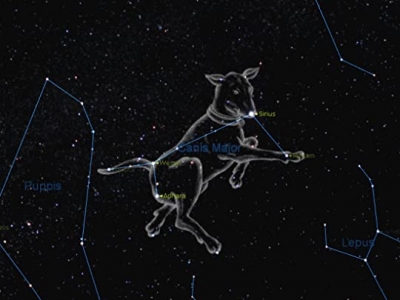
Star Pictures
If you look up at the sky at night, you might imagine pictures or shapes in the stars. Long ago, people used their imaginations to find star pictures, too. To some people, one group of stars looked like a hunter carrying a club and holding the pelt of an animal he had killed. Other star groups looked like a crab, a bull’s head, and even a dragon! People named star groups after the pictures they made.
Today, amateur astronomers still use these star pictures, called constellations, to find the stars they want to study.
Star Stories
In ancient times, when people found pictures in the stars, they made up stories to go along with the pictures. People of different cultures sometimes had different stories about the same group of stars. Here are just a few of those stories.
- Scorpio
The ancient Polynesians told a story of stars that were born in a canoe. Scorpio is the tail of the canoe. A story from Australia says Scorpio is a crocodile, an opossum, and a water bird.
- Cancer
Ancient Greeks tell a story that the goddess Hera was angry with Hercules, the son of the sky god, Zeus. While Hercules was fighting with a monster, she sent Cancer the crab to distract him. The crab was crushed by Hercules’s foot. Hera rewarded the crab by placing it among the stars.
- Gemini
Ancient Greeks said that twin brothers, Castor and Pollux, were the constellation Gemini. A story from northwest Siberia tells of two elks running away from two hunters. The twins of Gemini are the two elks.
The Indians of Mato Grosso, Brazil, told a different story. The sun gave three flutes to men and taught them to play tunes and dance. Gemini is one of the flutes.
- Cygnus
For thousands of years, many groups of people have seen this constellation as a bird. According to one story, the Greek god Zeus turned hiniself into a swan to become attractive to a woman. The Aleut people of Alaska tell about a man who set off to hunt seal in a kayak. The hunter dips his oar into the freezing water. Cygnus is the kayak, the oar, and the seal hunter.
- Orion, the Hunter
There are many stories about Orion, called the Giant by Arabs and the mummy of Osiris by ancient Egyptians. To ancient Greeks, Orion was a giant and great hunter turned into stars by the gods. Three bright stars in the constellation represent Orion’s belt, and five fainter stars below the belt are his sword.
An Australian story is about three fishermen who make up the constellation Orion. A story from central India tells of the Sing-Bonga. The Sing-Bonga went to the heavenly blacksmith. The blacksmith made an iron plough. The sword and belt of Orion are the plough. Auriga, a nearby constellation, is the blacksmith, the bellows, and the fire.
- Ursa Major, the Great Bear
The Micmac people of North America tell a story about a great bear that wakes from a long sleep in late spring. He is chased by seven birds. In summer, the birds chase the bear across the northern horizon. In autumn, one of the birds strikes the bear with an arrow. The bear falls on its back. Blood drips down to Earth and paints the leaves red. In winter, the bear’s spirit enters another bear. The next spring, that bear gets chased across the sky.
In the U.S.A. and Canada, the seven brightest stars of Ursa Major are called the Big Dipper. The Chinese believe that those seven stars form a bushel measure used to bring food to people during a famine. In India, the seven stars represent seven ancient sages, or wise people.
The Sia Indians of South America tell about a giant beetle who was given a sack of stars to carry from the underworld to the world above. The beetle was told not to open the sack, but he did. All the stars scattered across the sky. A few stars were left in the sack and these were used to make patterns in the sky. We call these patterns Ursa Major, Pleiades, and Orion’s Belt.
Picture Credit : Google



